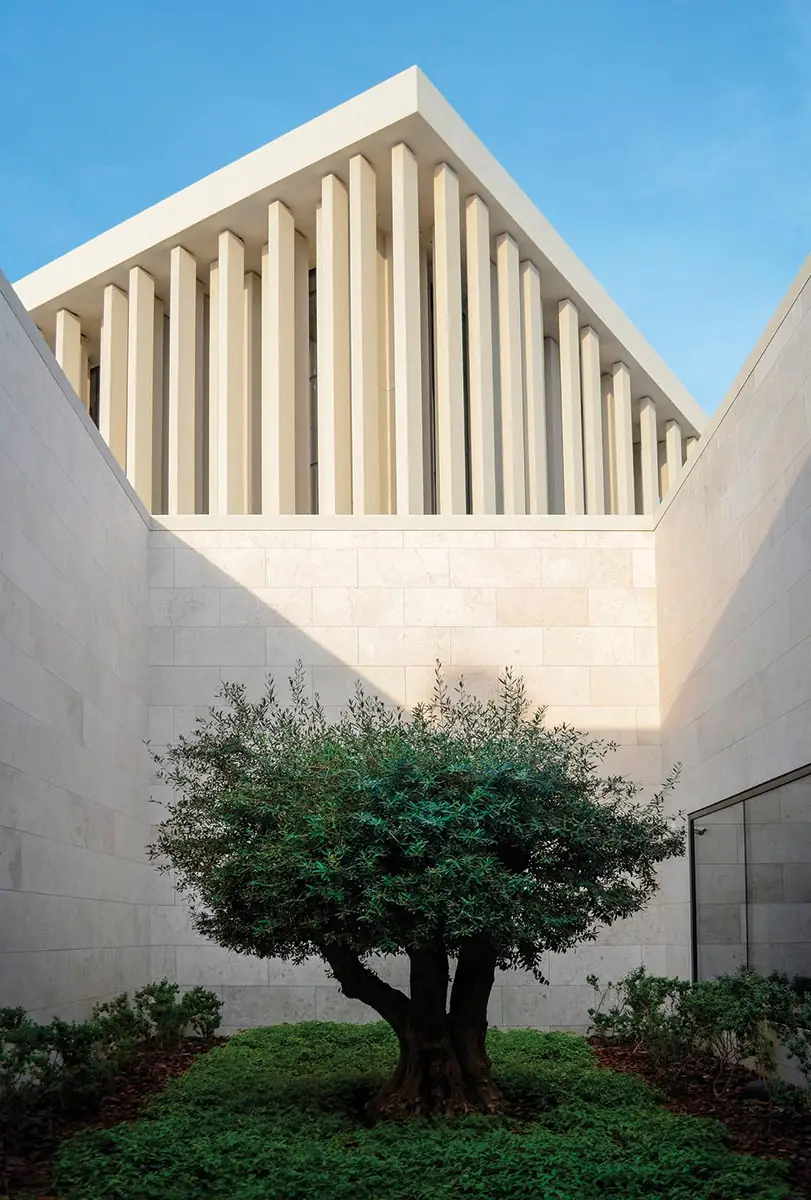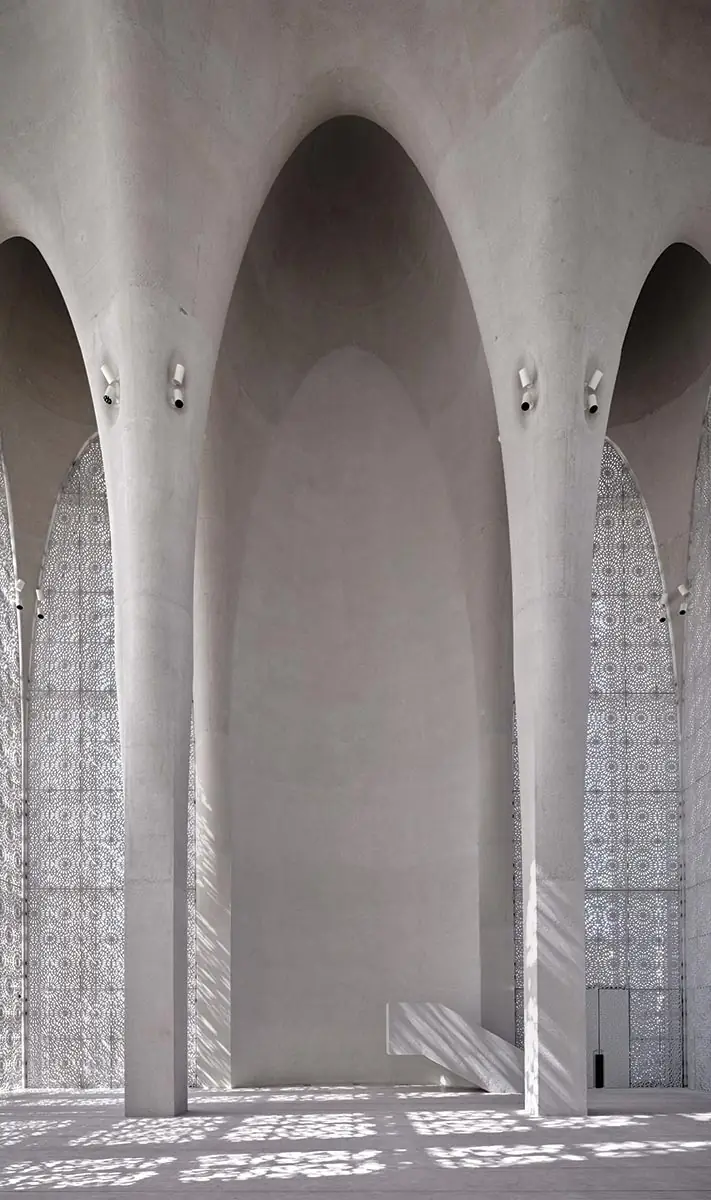With the opening of the Abrahamic Family House on Abu Dhabi’s Saadiyat Island earlier this year, David Adjaye joined the ever-growing list of international star architects with work in the United Arab Emirates. But Adjaye’s project is quite unlike the museums and towers for which Dubai and Abu Dhabi are known: it consists of a synagogue, a church, and a mosque, each a concrete cube of identical size, set atop a sweeping plaza in an intended show of religious harmony. The name of the complex refers to the three faiths of Judaism, Christianity, and Islam—and also seemingly nods to the UAE’s inauguration of diplomatic relations with Israel under the Abraham Accords of 2020.
RECORD contributing editor Izzy Kornblatt sat down with Adjaye to discuss the complexities of designing religious spaces in the UAE, the importance of the Abrahamic Family House for international diplomacy, and Adjaye’s planned Africa Institute in the emirate of Sharjah.
What are the key ideas underlying the design of the Abrahamic Family House?
The key thought is to create another narrative about the different strands of the Abrahamic faiths, and to move from a discourse that was about the development of each religion within its own locality to an idea that they have a commonality that unifies them. This idea of using architecture to find unity rather than specificity of different cultural developments is at the core.

1

2
The Abrahamic Family House in Abu Dhabi includes a church (1), a mosque (2), and a synagogue in one complex. Photos © Stuart Rennie (1), Arwa Alhati (2), click to enlarge.
It seems like a difficult thing to navigate, because the specificity of each of the religious buildings is still important.
That’s the contradiction that manifests in the project, because, even though we look for this unifying element, the three have different personalities. And that’s my acknowledgement of the fact that they do have these histories, and they do have these trajectories that are unavoidable. Even though they’re unified by the 30-meter by 30-meter by 30-meter cube and the courtyard, each one has a specific identity.
If you were to design a mosque or a church or a synagogue in much of the rest of the world, you would have a preexisting religious community to work with. But this was different—this was led by the government.
In a way, the negative of that is the positive in that it meant that I didn’t have to negotiate preconceptions of what the rituals are and the way the faiths should work. That was what was exciting about the project, because it allowed faith to just express what it wants to do rather than taking on the sort of narratives of what has happened for centuries. It’s a restart space. But [we also worked with] consultants who are leaders in each of the faiths—the chief rabbi, the cardinal, the imam.
What did you like most about working in the UAE? And what were the biggest challenges?
The most incredible thing was having a client that just took action on everything. A project like this would’ve taken at least a decade to deliver anywhere else. But working with a client that would make decisions right there on-site was refreshing. And the difficulties? Sometimes, because the client could override like that, we as architects felt that we were the second people in the room when certain decisions were made. That could be disorienting. But the client was great, and the team would always bring the conversation back to us.
Did you have any hesitation about taking on the project? It does raise complicated issues about the relationship of an autocratic government to these religions.
We did think about it. We thought about it in terms of working in the UAE, but it has more to do with seeing the conditions of how you build. How do the buildings serve the community? Are there freedoms for the community to be able to use these buildings in a specific way? I felt that those answers were yes. So even though it’s different from the governments that we normally work for in the U.S. or in Europe or parts of Africa, it was a situation where we could build and know the structures could serve the communities they were intended for. I felt I could deliver a building not within oppressive systems, but within a good contractual framework.
The project is also tied up with the UAE’s diplomatic efforts. Is that something that you thought about?
The impetus for me for the project—the reason for doing it—was a document that was signed by the Grand Imam of Al-Azhar and Pope Francis. This “document on human fraternity” talked about the ability of these religions to move past their entrenched positions into a new space. I thought that for the UAE to take that on as an agenda was admirable.
The UAE has been cited by NGOs for mistreatment of migrant laborers, particularly in construction. How did you go about ensuring that good working conditions were maintained on this site?
Worker safety was a high priority. It was part of the CSR [corporate social responsibility] on the project. Our site had no fatalities or issues, and it was something that we were very stringent about monitoring and something that we would not tolerate in any way. The labor conditions of the workers, their pay, and the places they stayed were all observed.
Can you tell us a bit about your next project in the UAE, the Africa Institute in the emirate of Sharjah?
The Africa Institute is about creating a postgraduate institution that builds upon the work that the government of the UAE has already started—a dialogue about African studies, but also about the Middle East and Africa and their long, complex, very entwined history. I’m excited that Salah Hassan, who is a professor I deeply admire, is the director. It’s his baby, and it will bring more light to that relationship, which I think has not been fully articulated in the academic sphere.
My interest in how Africa relates to the world connects me to working in the Middle East. So, for me, this is the next logical project. Unfortunately, because of Covid, the project slowed down. Even though it started before the Abrahamic Family House, it’s [only now] about to begin construction.





